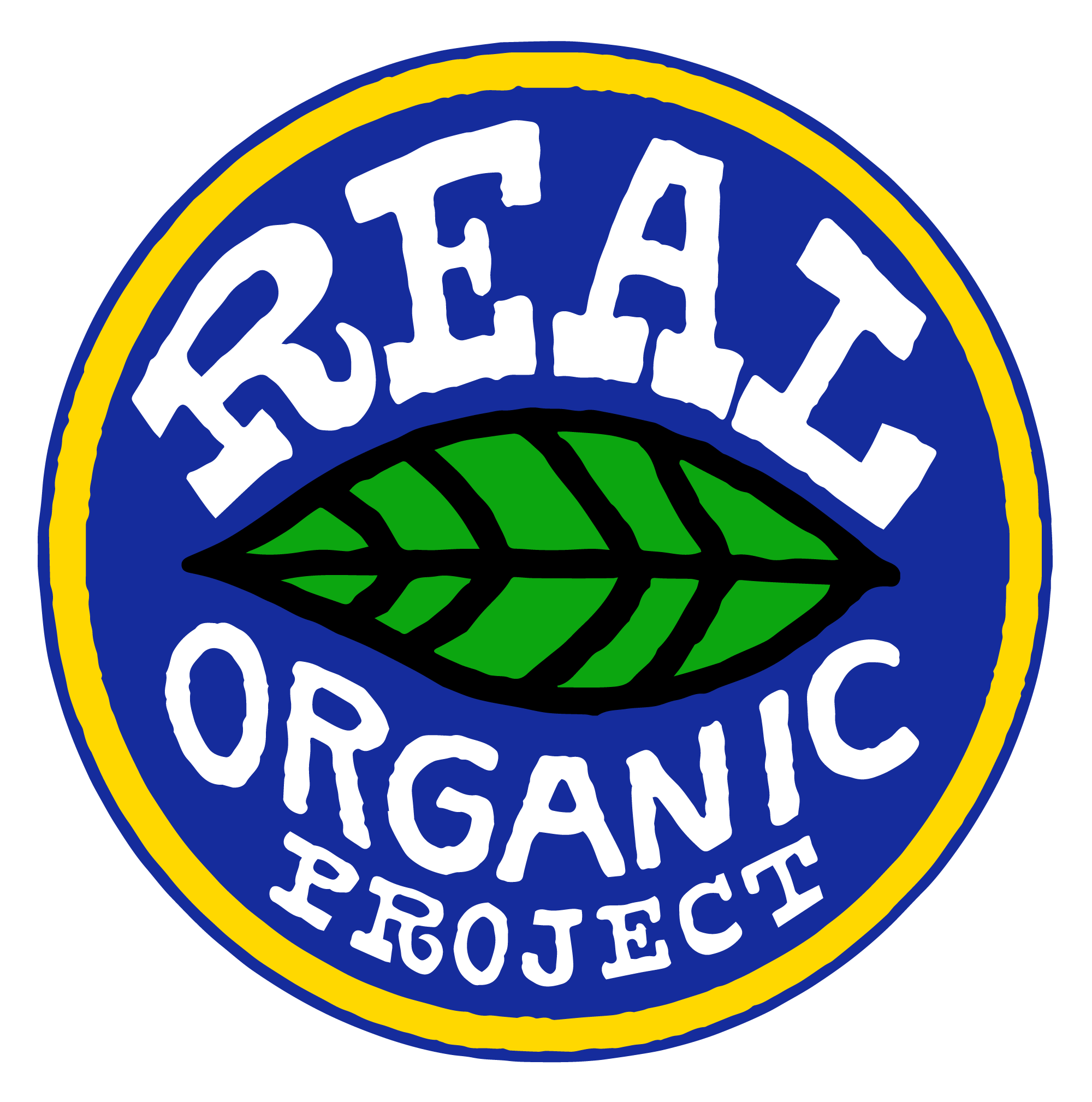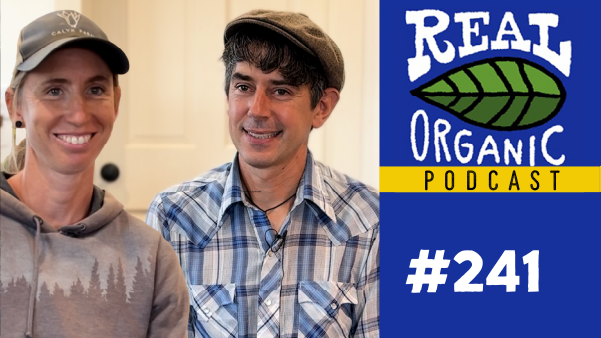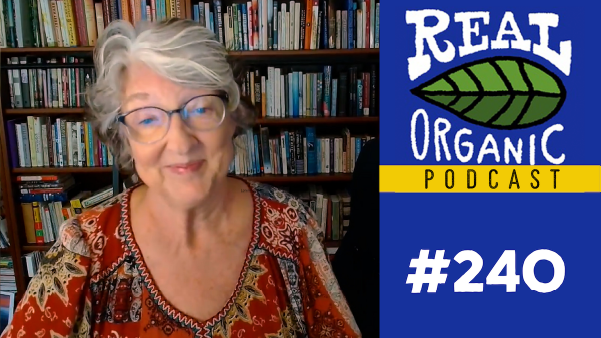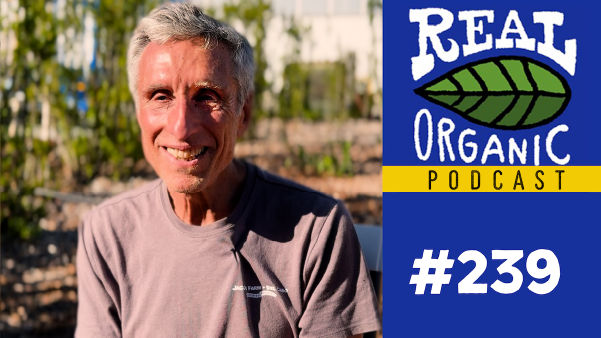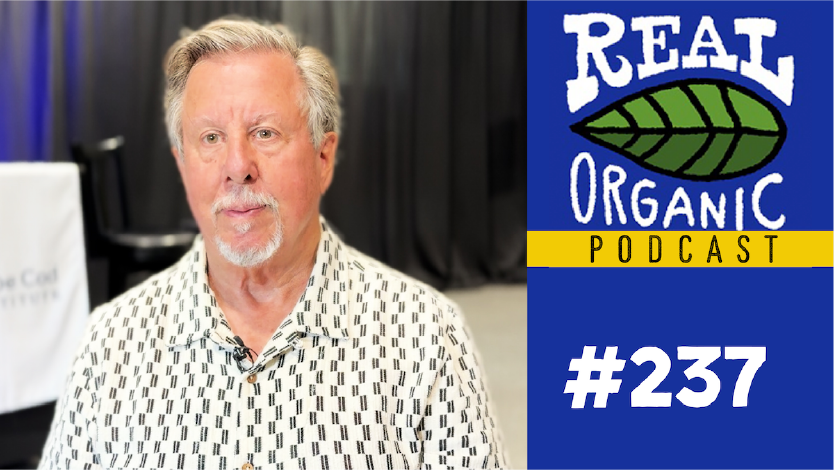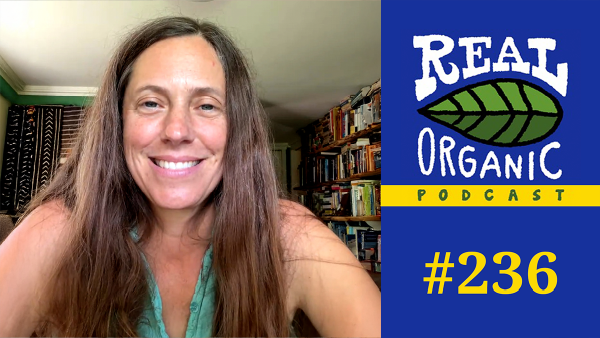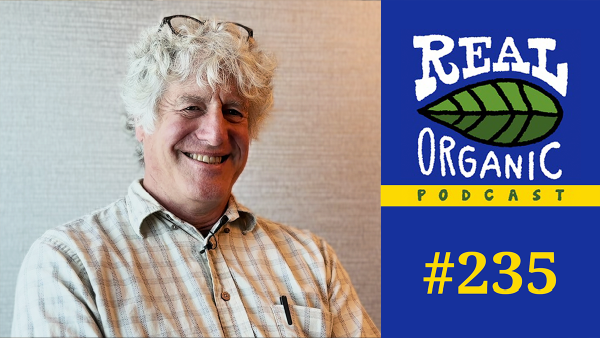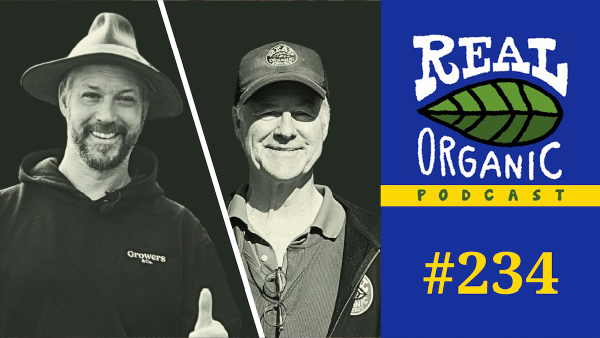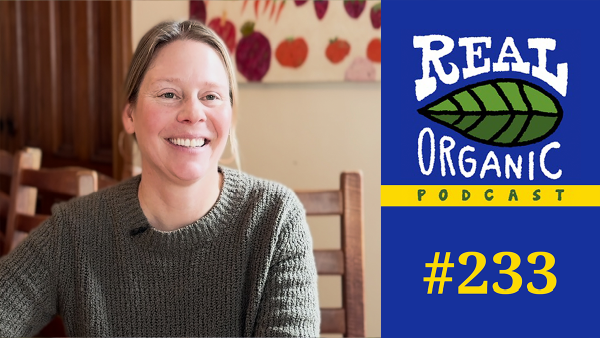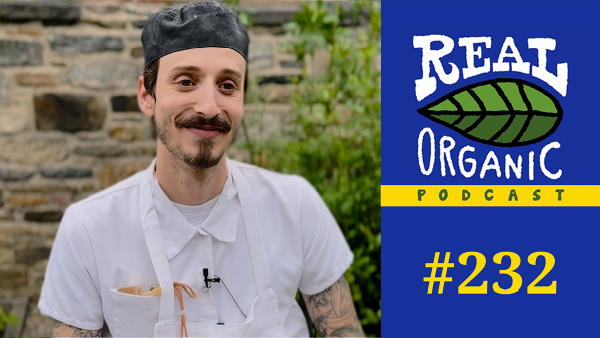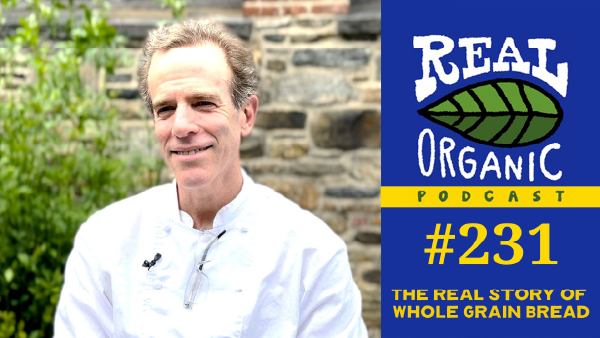Episode #238
Cameron Molberg: Real Organic Poultry At Scale
What does it take to raise real pasture-raised organic chicken at scale? Greener Pastures Chicken CEO Cameron Molberg shares how he built one of the only vertically integrated, pasture-based poultry operations in the U.S. Cameron explains why most “organic” chicken on the shelf doesn’t match consumer expectations – and how his team is doing it differently. From low stocking densities to daily pasture rotations, from small-batch processing to transparency in sourcing, Greener Pastures is proving that you can farm with integrity and grow.
Our Cameron Molberg interview has been edited and condensed for clarity:
You can subscribe and download episodes of our show through your favorite podcast app, our YouTube channel, or stream the audio-only version here:
Dave Chapman interviews Cameron Molberg Winter 2025:
Dave Chapman 0:00
Welcome to The Real Organic Podcast. I’m talking with Cameron Molberg today, my old friend. Welcome, Cameron.
Cameron Molberg 0:07
Thanks, Dave. Glad to be here.
Dave Chapman 0:11
I first met you when you came by my house on your way to your first Standards Board meeting of the Real Organic Project. We had communicated, but I don’t think we had met person to person, had we?
Cameron Molberg 0:25
No, we hadn’t. I’m on the livestock side. I think one of my passions is vegetable gardening, in addition to, obviously, my day-to-day job. But I have, historically, struggled with tomatoes. So, to see your facility, I was just blown away to see you could do it in such a confined space.
Dave Chapman 0:51
Well, good. Let’s talk about some of your other passions. You are the CEO of Greener Pastures Chicken. Can you describe that for me a little bit? Let’s give you some geography too, because you could be anywhere.
Cameron Molberg 1:12
Yeah, that’s right. Long story short, in 2015 I realized that there wasn’t anybody doing pasture-raised organic chicken on an annual basis. I could occasionally find a pasture-raised organic chicken at the farmer’s market. Again, typically, March, April, May like for us, we’re in Central Texas, so our growing season is pretty extensive.
Cameron Molberg 1:38
But it was few and far between, with poultry meat being the number one consumed protein in the United States, I felt like there was a market for it. At that point. I had already been doing pasture-raised organic eggs. We were selling to whole woods market, natural grocers, also on the feed side of the industry. Fifty to a hundred customers on the feed side, most of them were egg-laying hens, grass-fed cattle operations that would buy alfalfa pellets and various other things.
Cameron Molberg 2:15
We had pork producers and all the likes – goat producers and dairy producers. But again, huge void on the pasture-raised broiler side. I guess about 2017 I met up with…well, before that really. But 2017 is where we got our boots off the ground. We formed the company. We found a piece of land that was had been untouched for probably decades, and it was really good fit for us. A 35-acre location, just 25 miles east of Austin, and we started building the facility out in 2018. Again, nobody really had done this at the scale before, so we knew there was going to be some changes that we’d want to make along the way.
Cameron Molberg 3:02
Then 2020 came along. We did some extensive renovations, and then in 2021 we really hit the ground running. Then finally, 2023 is when we completed the construction of our on-site processing facility. Now, as long as we can maintain good quality products out to the marketplace, the sky’s the limit.
Dave Chapman 3:27
Give me a little sense of scale. How many chickens do you grow and process every year?
Cameron Molberg 3:35
We’ve only got about 15 months of the facility under our belt. We now have four locations where we grow out birds. So, we do have a lot of upward capacity on the live side. The difficult and interesting thing in the United States is you have these big plants that do a million birds a day, or 600 birds a minute, and then you have these small on-farm processing plants that typically can do about a single bird a minute and there’s really nothing in between.
Cameron Molberg 4:11
We knew that if we were going to build this plant to be a 60-bird an hour facility, or 1-bird a minute, that it was going to be too small. All the equipment suppliers in the United States are geared towards the million birds per day, or 600 birds a minute type of facilities. We also knew that was way too big. So, it was like a goldilocks situation where we had to find the right medium, and we could not find any of the equipment for the plant to do 25 birds a minute – what we had hoped to do.
Cameron Molberg 4:49
Eventually, we found a manufacturer out in Poland that produces equipment because in Europe, they still have small plants. They don’t have these mega factory CAFO plants. Again, doing 600 birds a minute – imagine that. It was tailored just right. We were able to bring them over from Poland, source all of our equipment from them, and ultimately build a plant that was ideally suited to the needs of our operation and the needs of our expected customer base.
Cameron Molberg 5:21
On a single shift, we can do about 50,000 birds a week. We can add a second shift, which would bump that up, obviously, double it to 100,000 birds a week. Then we can also add a second inspector and increase our line speeds from 25 birds a minute to 50 birds a minute. There’s a lot of upward mobility. We could do 200,000 birds a week on the high end, but the reality is the live production – we don’t have that much land available to us to accommodate that. Right now, we’re averaging about 12,000 birds a week.
Dave Chapman 5:58
Let me jump in here. What is the difference between Greener Pastures Chicken and a classic CAFO chicken, which are now certified as organic – horribly so. What’s the difference? What are you doing that’s different?
Cameron Molberg 6:19
There are a lot of differences. When we did our big renovation in 2020, we built the live production facility to take in as many efficiencies from commodity chicken as possible. We noticed that there’s a lot of labor loss with hand feeding and other things that could have been simplified or simplified in our system to reduce the necessary labor, but also at the same time to reallocate that labor to more husbandry instances or practices or responsibilities.
Cameron Molberg 6:54
What really sets us apart is our stocking densities are much lower or the birds essentially have more space is, I guess, what that translates to. After 7 to 10 days, we install enrichments in the brooder barn. What that does is those could be roosts or perches or hay bales – a bunch of different things. Things that the birds are going to want to jump on and exercise. They’re playful in the early stages. They’re very excited and intrigued by everything.
Cameron Molberg 7:33
Anyways, we include those in the area as well. What that allows them to do is get, unknowingly to them, considerably more exercise than that of a conventional bird. So, not only do they have more space, they have enrichments to allow them to get more exercise. Then at that point, we just monitor the thermal comfort, we monitor the air quality, their gait, their foot pad scores, their uniformity, and a few other things as well.
Cameron Molberg 8:08
But we have people walking those birds, going in and making sure they’re getting up and moving around on a continuous…at least three or four times a day, every single section. We still do small flock brooding, like 2,500 birds each. We won’t do a house that…like in commodity chicken, they’ll do 100,000 birds in a house. We start off small. Again, 2,500 birds or 3,000 birds per each section. Again, they have an ample amount of space.
Cameron Molberg 8:38
Depending on our time of the year, it really just depends. Our birds can be in the brooder in the summer for a minimum of maybe 16 days. Whereas in the north, it’s still a little bit too cold; the birds can’t regulate the thermal comfort. So, most people up north are going to keep their birds in the brooder probably 21-24 days until their down feathers have fully flushed out and they can self-regulate the body temperature a little bit better. Being in the south, it’s hotter, and we are less reliant on having to be in the brooder as much, which is kind of a blessing for us in the sense that one of the biggest expenses for us in the winter, aside from feed, is propane. In any way we can mitigate our use of fossil fuels, the better.
Cameron Molberg 9:23
After 18 to 21 days, then they go out to their mobile range coops, and they get moved every single day. The stocking density, again, is extremely low. These birds are on fresh grass. They are quite literally on fresh grass, as opposed to, again, a confinement operation, where they might be on a porch or just have a little pop-out on their house and no incentive to actually go outside. That’s the quasi-loophole when it comes to factory organic chicken – they put these little pop-outs on the houses and say, “Hey, well, if the birds wanted to go outside, they would.”
Cameron Molberg 10:06
Well, one, the farmer didn’t ever encourage the behavior from the beginning. So, the birds are going to more than likely stay inside, because that’s where they’re feed and the water is. They typically, in those setups, don’t put feed and water on the outside, so there’s really no incentive for that bird to go outside. Then there’s typically no shade cloths. It’s typically denuded or a concrete pad or gravel. There’s nothing enticing for that bird to go out in fresh air and in the sunshine. Our birds are quite literally in fresh air, in sunshine, and are on grass every single day after they leave the brooder.
Dave Chapman 10:48
That’s a massive difference, of course. Do you know the story of…was it called the country hen, where the first big case where they got porches permitted? It was our friends at Baystate Organic Certifiers who refused to certify this place and they took them to the USDA. Could you tell a little bit about what happened there?
Cameron Molberg 11:14
I don’t want to get into too much of the specifics, but long story short, they advocated that what they were offering their chickens was sufficient to meet the requirements of the organic standards, which by any rational person, that’s not an attorney arguing that case, they would think to the contrary. I don’t know if you want to elaborate on that too much, but essentially, it’s not much different than the USDA turning a blind eye to hydroponics, in the sense that if you read the rule as written, the organic standard is to improve soil health. If you take a soilless system, it just doesn’t make sense.
Cameron Molberg 12:08
But anyway, I think the real unfortunate circumstance in that scenario is that the American consumer, or at least anybody that purchases those organic products across the world has the expectation that the birds and the livestock are going to be connected to the grass that’s connected to the land. What that did was it made it permissible for those two to be mutually exclusive – for the bird or the livestock did not have to be connected to the land anymore.
Dave Chapman 12:40
Yeah, and live in a very strange and somewhat grotesque environment. It’s interesting to me that it seemed like that case was a tipping point, and that after that, all of the big CAFOs said, “Okay, we can do this just the way we want to. We just have to change the feed, but we don’t have to grow the chickens any differently from how we do every conventional chicken.” It was such a rush.
Dave Chapman 13:12
The thing that’s interesting to me about both hydroponic and CAFO production is that eaters – the consumers, the customers – don’t know what they’re getting and are not getting what they think they’re getting. I don’t think people go to the store to buy organic eggs, thinking that they’re buying them from chickens who have been packed in and have never been outside in their lives.
Cameron Molberg 13:18
The consumer would not believe it if you told them, and they would be shocked if you showed them photos of it.
Dave Chapman 13:38
I was just having a call with somebody before this, and I said, “If we just had a video camera and at every egg and milk in the store showing this is where they came from, then the real organic eggs and milk would – at whatever price – win. People would say, “I’ll pay the extra. That’s what I want.”
Cameron Molberg 14:10
With the egg shortage right now, fortunately it hasn’t really hit the organic producers as much, but I do find myself, time to time, having to buy eggs at the grocery store. I went into one…I won’t name the grocery store. They had one dozen jumbo organic eggs left, and I brought them home. The next day, I cracked open a few, and I tasted them, and I was like, “These taste like factory eggs.” When you’ve been eating pasture-raised eggs for 15 – 16 years, the second you take a bite into a factory-raised organic by default confinement egg, there’s nothing to it – lackluster.
Dave Chapman 14:54
That’s right. Of course, what you’re tasting is the nutrition. So, not only does it not taste good, but it isn’t nearly as good for you. There’s a few things I want to touch before we go on. One is; I have to mention that one of your partners in Greener Pastures Chicken is Von Miller, right?
Cameron Molberg 15:23
Yeah, that’s right. Von is currently with the Buffalo Bills. Previously he was with the Los Angeles Rams, won a Super Bowl with them, and then Super Bowl 50 with the Denver Broncos. He was the Super Bowl MVP that year – had a phenomenal game. A future Hall of Famer and the works there. But Von studied poultry science at Texas A&M. A lot of people don’t know that.
Cameron Molberg 15:51
I studied animal science, food technology, and institutional management at Texas Tech. But then we have a third partner who also graduated poultry science at A&M, so I’m the black sheep. We don’t have any ruminants on the farm, except for when I’m playing the black sheep. All that being said, it is really interesting, because Paul and I started brainstorming this idea in 2015. I had my frustrations that nobody was producing a pasture-raised organic broiler chicken on an annual basis, and he recognized it as well. Serendipitously, it came out like, “Von has been interested in getting into organic agriculture, and we have this contact information, so maybe we’ll reach out to Von.”
Cameron Molberg 16:41
Sure enough, we reached out to Von. He’s like, “You’re not going to believe this, but I was just talking to my dad about her a week ago, and we’re talking about the exact same thing.” Sure enough, in 2017, that’s when we all came together and decided to create Greener Pastures Chicken.
Dave Chapman 17:02
That’s amazing. Was this a long dream of his to…?
Cameron Molberg 17:10
Yeah, it actually is. It’s hard to tell where his career is going to take him. Early on, he figured after his career – once he retires from the daily grind of the gridiron – he wanted to be on the farm and stuff like that. I still see that happening at least much more frequently when he’s not tethered to the NFL. A lot of people don’t realize how much these people train. During football season, like from July through the Super Bowl, these people are pretty much inaccessible unless they’re on their bye week. They’re always training, they’re always studying, and they’re always looking at film. Then in the off-season, they’re still training – they’re still doing the same thing, but they don’t have to report to the camp or whatever.
Cameron Molberg 18:04
At the same time, in the off-season, he’s got a couple of weeks here and a couple of weeks there, and then, sure enough, football season starts up again. He’ll come down several times a year to check on the facilities and see how things are going. We connect by phone and email and all that good stuff. But the way his schedule is right now, being an active player in the NFL, it’s really difficult for him to find the time to get down as much as he wants to. But after his career is over, if he doesn’t land some other type of gig directly related to the NFL, then I’m very certain that we’re going to see him much more frequently.
Dave Chapman 18:46
That’s great. I don’t think I ever told you, but I’m going to interview a man named Ladd Harris, who is a wellness coach for an NFL team for the Houston Texans. He’s close to your home base there. He’s fantastic, and he’s been getting Hugh & Lisa’s berries from King Grove for the team when they’re in production, and they ship them to him in Houston.
Dave Chapman 19:15
It’s such an interesting conversation because they’re just looking for peak performance. Of course, in the old days, they didn’t look at diet at all for these guys. But now they’re looking at it a lot, and they’re looking at real organic as, “How do we get the best food for these people?”
Cameron Molberg 19:37
It’s funny you bring up Ladd. He’s a great guy. This is one of the huge benefits of being part of the Real Organic Project because Ladd reached out to me – about almost two years ago now – and he asked me about raising chickens for the Houston Texans. I was like, “Well, yeah, we can do that, but we’re not really set up to do it the way you want it right now,” because they wanted a fresh program. Without our processing plant, we didn’t have a fresh program. We only had a frozen program, which means everything that was processed had to go in the freezer. For folks in the food service, that’s a hassle, because then you have to allocate space to thaw that product before you even get to the point of cooking it.
Cameron Molberg 20:21
I sent Ladd some samples and he tried it. A couple of weeks later, he was like, “Yeah, you know what? I’m not too concerned right now about the fresh or frozen. We want to onboard you right away.” I was like, “Man, that’s fantastic.” For about a year and a half – I’d say 20-some-odd months now – we’ve been servicing the Houston Texans and they’re an excellent account. They totally get it. It seems so obvious that, you look at the diets of the Olympic athletes and these top performers, but then, when it comes to like the diet for an NFL player, the average diet…
Cameron Molberg 21:03
Part of the reason why Von was so interested in the organic chicken farm was because, when he first got in the NFL, he had a serious injury. He realized that if he changed his diet, not only would his recovery time improve, but his recovery in general would improve. It hit him early on in his NFL career… I can’t remember if he’s been in the NFL for 10 or 11, or maybe even 12 years now, but it started becoming really important to him.
Cameron Molberg 21:03
He advocates it to his friends and his colleagues and says how important diet and nutrition are as well. It’s really great when somebody like Ladd Harris from the Houston Texans reaches out and says, “Hey, we’re actually really interested in the diet and nutrition of what our football players consume.” I’m like, “Yes, it makes sense. Thank you.” Finally, it’s getting through to people that there is a correlation between what we eat and how we perform.
Dave Chapman 22:00
Yeah, of course. It’s fascinating because these guys are performing at such a high level. I asked Ladd, “Do the players carry this forward when they’re not in training? Do they eat differently?” He said, “Not the 19-year-olds. They feel like they’re bulletproof. They’re just at the top of their game.” He said, “Someone who’s been in the NFL for four years, and they’re really looking to get that fifth year or the sixth year, they’re looking very carefully at what they eat. They want to keep their game at its very top.” They’re older; it’s not as easy.
Cameron Molberg 22:44
Yeah, I know. It’s ridiculous. I’m in my early 40s, and I can wake up any day now, just having slept wrong, and I’m like, “What in the world happened there?” I’m not looking forward to what 50, 60, 70, and 80 are going to look like. But the reality is, if you eat well, sleep well, take care of your body, it’ll perform for you.
Dave Chapman 23:08
I’m 72, and I still feel very good. So, it’s all good food.
Cameron Molberg 23:13
Yeah, tomatoes.
Dave Chapman 23:15
Yeah, that’s right. You make me think I really should send some tomatoes to Ladd so that they can up their game. That’s inspiring to hear about Von. I obviously need to talk to him sometime because he’s a person of significance in this. You’re a very activist farmer, Cameron. You spent five years on the Real Organic Standards Board; you’re the president of the Cornucopia Institute?
Cameron Molberg 23:46
Yeah.
Dave Chapman 23:47
Why? Those activities takes a lot of time.
Cameron Molberg 23:51
Yeah, it does. That’s a good question. I’m really passionate about what I eat and what I consume. I’m really fortunate that I was raised to appreciate good food. I had my parents and my grandparents that were very close to growing food. It always hit home to me, I think really what… When I was in college, GMOs started to be talked about and experimented with. At that time, I was studying animal science and food technology. I was really, really interested in getting involved in the food system. But the more I learned, especially being in food tech, the less I really appreciated what I was learning.
Cameron Molberg 24:42
We were doing basically everything that’s being done now. It is like the tip of the iceberg compared to what the industry does nowadays with flavor enhancers and basically adjusting food formulations to make it palatable and basically addictive. I didn’t want any part of that. But I guess, long story short, I really wanted to advocate for authentic organic agriculture. There are some similarities in terms of what the mission of the Real Organic Project is versus what Cornucopia is. We have different paths in how we try to achieve that. I think, arguably, you could go either way, but nonetheless, it’s always been a big passion of mine to support this movement in whatever way I can.
Cameron Molberg 25:39
Being at the feed mill and the egg operation and working with Whole Foods in the past – Central Market, H-E-B, and all these folks these days – I realized that one of the hardest things to do is to change consumer buying habits. The other thing is fighting for their time and attention to educate them. So, I felt as though that the Real Organic Project and Cornucopia Institute were two of the areas that were most effective, not only working directly with the farmers, but also being the go-between the farmer and the consumer. They are ones that I could actually advocate on their behalf.
Cameron Molberg 26:22
That’s really what motivates me at the end of the day – trying to change buying habits. I’m still advocating for those that are working hard to either preserve their family farms or new farmers wanting to get into this movement, or whatever the case may be. But it boils down to just preserving the integrity of the industry.
Dave Chapman 26:46
Yeah, it’s interesting. I understand a bit in poultry about the erosion of transparency in organic that’s happened in organic certification – not in real organic farming, but in organic certification. Is that true for other kinds of livestock? Is that true for cattle, for pigs? That there’s been this loss of transparency so people go to buy organic, and they’re not getting what they think they want. I always tell people, if you don’t know, buy organic – USDA Organic. That is better than not. But if you possibly can, buy real organic, because there’s still a world of difference there, too, or can be. We don’t know. That’s the problem with the USDA organic. We don’t know – is this is real organic, or is it a confinement?
Cameron Molberg 27:46
The reality is, if it’s at scale, it’s more than likely a confinement operation – that’s the reality of the situation. It’s hard to find people that are doing the real organic. Again, going back to the importance of the Real Organic Project – it’s a great resource for consumers to be able to find some of the products that they’re probably searching for that qualify to the standards that they’re hoping to support.
Cameron Molberg 28:21
As it relates back to your question, is the same thing happening with pigs, cattle, and dairy? Oh, yeah, absolutely. The bulk of the dairy production in the United States comes from CAFO operations. You don’t see a whole heck of a lot in comparison. Anyways, you see it in the pork industry, in organic pork. You see it in organic beef, although to a lesser degree. But I think where it’s worst is in the organic dairy and in the organic poultry.
Dave Chapman 29:00
There was an attempt to regulate animal welfare in the National Organic Program. The first one was the OLPP (Organic Livestock and Poultry Practices). That was passed by Vilsack at the very end of Obama’s term. Then Trump rejected it immediately. Vilsack, once again, brought back a version of it called the OLPS. I’m just curious, because I have to say, I have my doubts. It’s great to see reform, but I’m not sure this was a reform. Do you think that the OLPS is really going to cause any CAFO to break a sweat, or they just going to go, “Oh, we just have to put a couple ramps here and we gotta open up a little door there?”
Cameron Molberg 29:53
I think it’s going to be an improvement. Is it what we wanted? No. Is it a step in the right direction? Yeah. Fingers crossed, let’s hope that it doesn’t get retracted somehow. At the end of the day, those that have grandfathered in, I believe, have up until 2029 to make the necessary changes. They’ve got a five-year runway, so anything can happen politically in five years to basically have them not concerned about it at this time. But if it holds, and that grandfather clause does expire, and these CAFOs do have to adhere to the written rule, then that means there’s going to be no more beak tipping, and there’s going to be no more other things – physical alterations that would happen to the birds.
Cameron Molberg 30:43
Ultimately, they would have to have legitimate access to the outdoors. Now, would that qualify my mind as quasi free-range? Probably. They are going to do it to the minimum standard. But is it better than being cooped up right now and having a concrete porch that’s been stamped? Yeah, it’s better. When I look at changes in the program, especially over the last 10 – 15 years, typically they’ve gone in the other direction. So, I am pleased to see that at least this is moving the other way around.
Dave Chapman 31:31
You challenge my cynicism, which is good. I have talked to people who have talked to the CAFO operators, and they’re just rolling their eyes and saying, “This is not a problem.” But I’m thrilled if it is a problem. I’m thrilled if it does create real change.
Cameron Molberg 31:45
It’s not going to be earth-shattering. It’s not going to raise the bar so much that we’re on the European standard or of organic. But it’s…
Dave Chapman 31:58
The European standard for livestock is much stronger?
Cameron Molberg 32:01
Oh, absolutely. It’s much stronger over there.
Dave Chapman 32:05
Please tell me about that.
Cameron Molberg 32:08
They have to have access to the outdoors. Their stocking densities are much lower. Just the welfare of the bird is a consideration in the European standards, whereas in the United States, up until recently, it never was. So, when it comes down to it, yes. When there was all this hoopla about people wanting to abandon the USDA Organic standard – I guess when they started allowing hydroponics – I was like, “Well, why don’t we get a European certifier and start certifying under the European standards?” But then again, Real Organic Project came along.
Dave Chapman 32:48
I said the same thing, by the way. I told Miles McEvoy, “I think I’m just going to get certified by the EU.” He said, “That will not qualify. You can’t use the word ‘organic.'” I said, “Well, maybe I’ll get double certified. I just won’t mention the USDA certification.” But yeah, we got Real Organic Project, so we’re doing that. How would you feel if there wasn’t a Real Organic Project – about just putting your birds out as certified USDA organic? Would you feel challenged by that? I would, selling our tomatoes. I said, “Oh, that’s not what I mean.”
Cameron Molberg 33:36
The interesting thing here is, I think people see that – we call the seal a ‘bug,” like the USDA Organic bug, the Real Organic bug – that’s just packaging terminology. But I think when the consumer sees that, I don’t know how many actually go to the website, but I know some of them do, and they do try to educate themselves on what they’re actually paying for. We’re not the cheapest chicken on the shelf, so there’s some self-education on their part that they’re doing, which is fantastic.
Cameron Molberg 34:11
Would I feel comfortable not having the Real Organic Project seal on our package? Probably not, because at that point, you’re comparing apples to apples, when in reality, we’re apples to oranges. Having that the Real Organic Project seal there is a way, again, for the consumer to have the faith in the product at the end of the day. Whereas, going back to just truly USDA Organic – at the end of the day, if you put a commercial product in front of me versus an organic product, I’m going to pick the organic one a hundred times out of a hundred. But if you put ROP next to organic, then I’m going to pick the ROP a hundred times over organic.
Dave Chapman 35:04
Let’s jump ship for a minute. Let’s talk about avian bird flu because that’s a big topic in the world right now. In America, it’s a disease that is spreading pretty rapidly. I believe it’s transmitted by wild birds – that’s my understanding. I know it’s hit both conventional and organic, and it’s a pretty bad disease. Could you talk about it? Do you have any experience firsthand?
Cameron Molberg 35:34
Unfortunately, not firsthand. Our closest AI-positive case to any of our four locations is 30 miles west – that’s a little bit too close to home. That was in a flock of wild ducks. Highly Pathogenic Avian Influenza is a serious disease – it is a virus. At the end of the day, if your birds get it, then ultimately your birds are going to die. If any of them do survive, they’re going to have to be put down, because, again, it’s highly pathogenic. It can transfer from bird to bird, typically through the manure, the droppings, from one bird to the next, then just stepping in the manure…
Cameron Molberg 36:26
Part of the reason why it’s impacted conventional agriculture more so, I think, than in the organic agriculture is because stocking densities on the conventional side are much heavier than that of the organic side of the industry. If one bird gets it, you’ve got these CAFOs that have maybe 100,000 birds in it – it’s petri dish. It just explodes in it. Ultimately, all the birds have it within a day or two. All those birds have to be put down. Everything has to be sterilized, cleaned, down, obviously depopulated. There’s a waiting period. If there’s an AI-positive case, it could be 21 days. It depends on your local authorities and the USDA as to whether or not they’re going to allow you to put another flock into that enclosure. But ultimately, at the end of the day, it’s very dangerous, very serious.
Cameron Molberg 37:25
We do everything on our end to prevent it from impacting our birds. We have seen it, obviously, infecting dairy cattle. There have been some human cases as well. The goal is to not get COVID or any of those other things. But from historical knowledge, if we can keep the pressure down, people do what they need to do, then we can prevent the spread of it. If we can prevent the spread of it, then it slows down its mutating and becoming zoonotic and then becoming another pandemic or affecting other species of livestock.
Dave Chapman 38:04
The best strategy for control here is isolation. I went to a certified organic egg operation, semiconfined. It was fascinating. This was some years back, but they had a security checkpoint, and they were looking under my car with mirrors. I thought, “What are you looking for under my car?” If you’re going through a checkpoint and they’re looking for bombs – that’s what it was like. What were they looking for? Some dead bird that got wedged up in there?
Cameron Molberg 38:45
It could have been. There’s weirder things that have happened. But ultimately, they’re looking at the undercarriage to see whether or not, at least it’s visually clean. What we do is – at least on our farm – we’re very protective. One, none of our employees are allowed to have their own birds. That is an FDA requirement when it comes to eggs, but that’s not necessarily a USDA requirement when it comes to raising broilers. But all that being said, our employees are not allowed to have their own birds. If they do go onto a property that does have, let’s say, another flock of birds, there’s like a quarantine period. But also, at the same time, they need to wash their vehicle before they come back onto our property.
Cameron Molberg 39:39
Right now, especially since we’ve had that AI-positive case 30 miles west of us, we limit visitors to essential personnel only. So, only our employees, inspectors, and anybody, let’s say, it’s out outside of our skill set – if we can’t do something with the electrical or plumbing, then we’ll bring in a plumber and electrician. We’ll sanitize the wheels of those vehicles when they come onto the property. We’ll sign them in, make sure that we have documentation of who showed up, and then when they leave.
Cameron Molberg 40:10
But then also at the same time, if they have had any exposure to any birds whatsoever, at least three to seven days prior to visiting our location, we may actually sterilize the outer carriers of the vehicle as well. We’ll typically use peracetic acid. Peracetic acid, for those that aren’t familiar, is basically a combination of hydrogen peroxide and acetic acid. Acetic acid, for those that don’t know, is basically vinegar. What the hydrogen peroxide does is it’s an oxidizer, so it penetrates the bacterial cell wall. Then the acetic acid will actually go in and do the rest of the work and kill the remainder of the cell.
Cameron Molberg 40:57
So, it’s a really good, safe sanitizing agent for anybody that’s listening that’s not using any type of chemical intervention. Again, it’s a combination of hydrogen peroxide and acetic acid. It’s highly unstable in the sense that the shelf life on the product – if it becomes exposed to oxygen – it’ll do its work, it’ll kill the bacteria, and then within an hour or two, it’ll dissolve into water, hydrogen, and oxygen. There’s no residual like chemical bleach.
Dave Chapman 41:30
That’s like wiping down, stopping the transmission. Let me ask this, because I know this is a question everybody has: can you get bird flu from an egg if a chicken had bird flu?
Cameron Molberg 41:43
That is a good question.
Dave Chapman 41:46
I’ve read of animals like people’s cats getting bird flu from raw milk.
Cameron Molberg 41:55
I think you can get it from a raw egg, but I would highly doubt you could get it from a fully cooked egg. Don’t quote me on that, because… that’s a good question. Nobody’s ever asked me that, and I haven’t even had that…
Dave Chapman 42:08
Well, somebody just asked me. I like, “Well, I’ll ask Mr. Green Genes who’s here and see what he says.”
Cameron Molberg 42:15
I think the main takeaways are, when we do bring in the automobiles from anybody that it’s not associated with our farm. We have a location where they go to. Then we sanitize their feet, their shoes, and then on top of that, they’ll have boot covers. If it’s like an inspector, like a USDA inspector, that has been at a different poultry farm within the previous three days, we have them completely suited up.
Cameron Molberg 42:46
We had that happen at the egg farm. We had three FDA people come out that had been at a different egg farm within three days previous to visiting our facility. It was hot. It was like 105 degrees outside. I was like, “Sorry, you picked the wrong time to come visit our farm.” They were just doing a routine inspection for salmonella compliance. I was like, “Y’all, you’re going to have to suit up. You’ve been at another farm. You cannot go to another farm to potentially infect our birds.”
Cameron Molberg 43:15
But the reality is, we’ve got to be very proactive. I hope all real organic and non-real organic farmers are being proactive in making sure…because at the end of the day, if you have one egg-laying hen, you’ve got $20, $25 invested in that thing before it even rays an egg. Basically, what it boils down to is that, I would say, 90% of AI-positive cases could be prevented if there’s proper training and people follow through with the strict hygiene of the staff.
Dave Chapman 43:51
I have a question about that. I was thinking about it. I know of some genuine pasture-raised flocks that have been infected. Sometimes you think, “Well, if they’re just in healthy conditions, they won’t get sick, but okay, they can get sick.” It seems to me that the pasture-raised birds are going to get more exposure from, say, wild birds, whereas the CAFOs, it’s much less likely it gets in, but if it does, it just cleans the house.
Cameron Molberg 44:27
There’s arguments both ways. The reason why, again, a wild bird can and birds do get into those giant CAFO houses – whether it’s little fence or something like that – there’s always openings in those houses where something can get in. But the big culprit in that area is that something came in, typically on an employee’s shoe, where they came into contact with the manure or something of a wild bird that had been infected, and then, ultimately affected that other flock.
Cameron Molberg 45:02
Now, when it comes to the pasture-raised model, obviously, the birds are much more exposed to that. There’s a lot of techniques and tricks that farmers typically utilize to keep wild birds from their farm. I know some people shooting buckshot – not at wild birds, but in the general vicinity – to scare them away. Sometimes that works, but really, it’s stuff that’s basic. I was asked this question, I think in September of last year at the Real Organic Project at Churchtown. They were like, “What techniques do you use?”
Cameron Molberg 45:41
One of them was a scarecrow. As silly as it sounds, a scarecrow with flailing arms still works. As dated as it sounds, it’s still a pretty effective way to keep wild birds away from your property. The flip side of all this, you also got to take into account that the UVA and UVB from the sun, when it comes in direct contact with poultry nerves, it’s going to sanitize it – it’s going to sterilize it. You may have increased exposure in the short term, with a pasture-raised operation, just depending on whether or not you’re in a certain flyaway but at the end of the day, if you let your land rest, and you let the sun do its work, and the soil and the environment do its work, it’s going to take care of the virus as well.
Dave Chapman 46:40
Okay, great. Thank you. I’m just trying to get a sense from the bird’s-eye point of view here, of how you’re thinking about this pretty serious problem. People have their entire flock destroyed, and I can’t imagine how devastating that is.
Cameron Molberg 46:58
Well, I should add just a couple more points on that since this is a really important topic. I would say that if you’re in a highly susceptible area, and you do have avian influenza detected in your area, and you are strictly a pasture-raised operation, depending on whether where that AI-positive case is – north or south of you – if it’s south of you, then it’s probably past, but if it’s north of you, then…
Cameron Molberg 47:25
What we do is we have a veterinarian. Anybody that has an organic systems plan that has livestock should have a veterinarian listed on their paperwork. Those vets, if they’re qualified and you’re raising birds, will be tracking where AI-positive flocks are in the United States. My vet, a couple of weeks ago, before we had that positive case 30 miles west of us – two weeks before that – we knew that those birds were in Oklahoma. We knew that, three weeks later that those birds could potentially be in our general vicinity.
Cameron Molberg 47:55
So, having a qualified vet that’s monitoring that on the outside is really important. Going to the CDC’s website and the USDA website, and looking for AI-positive cases in your general vicinity is also really important. But if you have an AI-positive case, I’m talking like 10 to 15 miles of you, I would put your birds up. For the safety of the flock and for the well-being of the farmer, it is in their best interest, in those scenarios, to close up the birds, and limit their outdoor access temporarily until that threat is passed. The threat will pass within days. But the reality is, they really need to hunker down when the threat level does get to a critical point.
Dave Chapman 48:49
I just heard that the administration was suppressing the data about bird flu. I don’t know if that’s true, but I heard it from a fairly reliable source. Have you heard of that at all?
Cameron Molberg 49:01
I haven’t heard of that, but I would not be surprised.
Dave Chapman 49:07
I don’t know why. I don’t know if that’s to keep the stock market happy; I don’t know. It seems like we all need that information.
Cameron Molberg 49:14
Yeah, we definitely need that information because it allows us to make the right calls in the field. Fortunately, we weren’t in a situation at that time where we felt that we needed to confine our birds, and we’re very thrilled about that, but I’d rather have that information and not be flying blind when we’re dealing with something so critically important.
Dave Chapman 49:36
Yeah, absolutely. I wanted to ask about something I noticed that was very troubling. When Theo Kristin testified to the Senate Agriculture Committee – he’s a major hydroponic producer of certified organic tomatoes – in his written statements, he was clearly saying that they should stop wasting their time on side issues like the population density of a chicken house. It was a direct callout to support the CAFOs. I thought, “Wow, there’s this thing.” Because, of course, he has no direct economic relationship with confinement poultry. But there’s this thing where these companies agree to support each other. Have you experienced that at all?
Cameron Molberg 50:32
Not directly, but it is one of those industries now where you scratch my back, I’ll scratch yours. At the end of the day, it is capitalism at its finest, in the sense that we want the organic movement to grow. What was it? A $65 billion industry last year. The year before, and 10 years ago or five years ago, it’s like $44 billion industry. Everybody likes seeing improved or increased market share. It makes the trade associations, and the consumer associations feel validated. At the end of the day, it’s like, “Okay, we’re showing positive numbers here, and the movements growing.”
Cameron Molberg 51:18
But how is it growing? That’s the concern. I can’t speak for him in terms of what his motivators are, but at the end of the day, more is not always better. We always look at quality – quality over quantity. It’s unfortunate that there’s big players in the industry that they’re more interested in quantity or quality. The reality is we’re always going to be contending with that, and we just got to be smarter and produce better product and have better outreach. It’s definitely an uphill battle – it’s always been an uphill battle.
Dave Chapman 51:56
He also called for replacing representatives of smaller retail outlets like Moms. There was a small chain down in Maryland area called Moms, and there was a member on the NOSB, and he wanted Walmart. That’s who he wanted representing us to the USDA. I thought, “Well, of course. They’re constantly moving towards monopoly in distribution, in retail, and in production, and they work very well together.”
Speaker 1 51:58
Can you say there’s a penny earned, and they know that. It goes back down to, like, McDonald’s. One second of an employee’s work routine, they can save millions of dollars a year. Consolidation, confinement, all this stuff is just a way for them to make more money and not produce better quality product. It’s really unfortunate. Their American consumer is the one that has to suffer for that, and the real organic farmer, too.
Dave Chapman 53:02
That’s right. Cameron, a question I get all the time. I got it this week on a group call with a wonderful group of consultants who work for Rodale: What can we do? What can I do? It’s a tough question to answer, honestly. We’re pretty good at describing the problem. I have come up with my answers for this, but I’m curious what your answers would be after many years of wrestling with this tiger.
Cameron Molberg 53:37
That’s a difficult one, because, as mentioned previously, consumer education is one of the hardest things to do. Y’all do it through the Real Organic Project, we do it through the Cornucopia Institute. One area where we’ve made a lot of headway, at least recently, with Greener Pastures Chicken is we’ve gotten our chicken into some of the independent school districts in and around our farm.
Cameron Molberg 54:07
We have Manor ISD, Travis ISD, I think with maybe Austin Independent School District next year – fingers crossed. But what we’re looking at now is like more grassroots, and by ‘grassroots,’ like really grassroots, like starting off as young as possible. Not only do we sell them the chicken that we produce at the farm, we also educate them on how it’s different. There’s sometimes a little bit of pushback about that, because at the end of the day, were only a portion of their budget, and they can only allocate X amount of dollars towards purchasing Real Organic Project, pasture-raised organic chicken. Then the other supplier is going to be a large CAFO – that’s confinement operation and conventional.
Cameron Molberg 54:58
But what’s really exciting is that the kids, when they go to their normal lunch and they get the normal chicken, it’s just a normal day. Then when they get our chicken, they’re all excited. They’re totally stoked. They’re like, “Yeah, we’re going to get some real chicken this week.” It’s a long game for us. If we can start them off now where they’re having access to good-quality chicken at a young age – in a developmental age – hopefully that’ll stick with them. They’ll continue through their education, and then when they become young adults and are making their own food purchases, then they can seek out these products themselves. Again, that’s a very long play. But just trying to get in front of the consumer and make a positive impression when they’re young is really important to me.
Dave Chapman 55:52
I love it. We got to make sure that we feed our pro athletes real organic food, and we got to make sure we feed our kids real organic food, and then the twain shall meet.
Cameron Molberg 56:04
Exactly. Fingers crossed. I don’t know if it’s going to work. Ask me in 20 years.
Dave Chapman 56:10
Let me talk about a recent challenge. There’s been a lot of funding cut to everything in recent months. I was curious because they’ve explicitly talked about cutting funding for the transition to organic program, which Vilsack had committed, I believe a hundred million dollars for. They’re cutting it off very suddenly, so they’re not honoring contracts that were assigned.
Dave Chapman 56:39
Also, even they’re talking about cutting the climate-smart funding, which was more like $2 to $3 billion. Of course, a lot of that’s going to things that I don’t think are very smart for the climate. But a lot of it is going to organic. This is the most money that our government has ever spent on supporting this kind of agriculture, and unfortunately, it’s being taken away. Do you know anybody who’s going, “Oh my god! I’m going to have to lay off half the staff now?” Or is this just something you hear about or read about?
Cameron Molberg 57:15
No. In our area, I would say organic farms aren’t as prevalent as they are in certain parts of the country. We have a lot of vegetable farms down here. By a lot, it pales in comparison to like, the Northeast and California and certain other regions, like Pennsylvania. So, we’re a tight-knit group, but at the same time, I feel like it’s not necessarily affecting us directly as much as I think it’s probably going to affect other regions in the country.
Cameron Molberg 57:50
But at the end of the day, it’s definitely going to affect people. The cost-share program is really important, especially for these young farmers – the ones that work at like the incubators, the ones that are training them, and they’re trying to learn and get the education that they need so they can start their own organic farm. Whether it’s $750 or whatever, that cost-share program is going to allocate to that farm, their annual budget might be a hundred thousand dollars. So, a thousand dollar, that’s 1%. That’s something that they’re going to have to make up elsewhere.
Dave Chapman 57:50
Just to say for people who don’t know, the cost share is to cover the cost of certification for it to be certified as organic, which, in Denmark, would be totally free for everybody. But here it can be quite expensive. For a small farm that has a a thousand dollar bill, as you say, that’s 1% of their entire budget.
Cameron Molberg 58:47
Some of these small farms that are just getting off the ground, they don’t have a a hundred thousand dollars budget. It could be $20,000, $25,000 budget. So, it makes up a huge piece. When I started farming, I didn’t start off with four locations – we started off small. We had 2,500 birds, and that’s all we had – 2,500 egg layers. We were selling to whichever grocery stores we could take with luck, and anybody that gave us a chance to put a good quality product on the shelf.
Cameron Molberg 59:19
At that time, the cost-share and these other grants that are available to the small farmers that are trying to get their foot in the door, it’s a big hindrance. It could be a big problem for them, especially if there’s other resources being cut along the way, like extension services and access to a whole slew of resources, whether it’s through the Farm Service Agency, etc. There’s tons of programs. Beyond just stuff that’s touching organic, it’s touching all farmers in various ways. I thought the farmer was supposed to be the backbone of America, but it doesn’t seem like we’re treating them that way right now.
Dave Chapman 59:59
I have one more just slightly challenging thing, and then I’ll turn it over to you. You were processing grain for farmers for some years. I consider there to be three kinds of terrible challenges to the National Organic Program. One is hydroponics, one is confinement, and one is grain. The grain problem has been mostly the one that’s just absolute outright fraud, that people have just lied and cheated on their paperwork. Mostly, but not entirely, mostly on imported grain, and then that suppresses the price for all grain.
Dave Chapman 1:00:49
It’s very hard for organic grain farming to grow when you’re competing against essentially conventional grain at a price that you can’t match. I think last I saw about half of the certified organic corn is imported, and about two-thirds of the soy that’s certified as organic is imported. These are huge volumes, and it’s mostly going to feed animals. I’m just curious, as somebody who is involved in processing, do you have thoughts about this? Did you experience it firsthand?
Cameron Molberg 1:01:26
No. We were certified organic, but also at the same time, we’re Non-GMO Project verified, which is redundant. It adds to consumer confusion, but we do it because there already is an established consumer confusion about whether or not organic is non-GMO, etc. Let’s not get into the politics of that. But all that being said, we did on-site testing. That was really important to us. So, not only would we test for aflatoxins and mycotoxins to make sure that what’s coming in isn’t going to make your animal sick and it’s within the FDA requirements, but we would also check to see if there’s, obviously, any GMO contamination or any other type of contamination that we could identify using…
Cameron Molberg 1:02:11
We used, I can’t remember the name of the system off the top of my head, but it basically used a lateral flow strip test. It’ll show you whether or not you have a qualitative positive or negative, that it either came into contact with certain chemicals, or whether it had any presence of GMO contamination and such. But that was us. That’s not to say that everybody was doing that. Obviously, some of the people that are sourcing these grains might be turning a blind eye to some of the things that are actually happening.
Cameron Molberg 1:02:41
In grain brokers who are out there, left and right, there’s a hundred grain brokerage firms out there that are trying to peddle and move product from one place to the next. I guess what it boils down to is a lot of those products come from like, India, and at the time, when I was in the grain business, China. Yeah, it’s cheaper. But also at the same time, if you’re trying to produce a high quality feed product…let’s go back to the soy beans. A lot of that stuff is crushed and made in India or China or just outside of Russia. There’s a whole bunch of…it used to be Ukraine, but not nowadays. You used to have a lot of organic production in those areas. That would be, well, I should say, “organic.” We don’t entirely know.
Cameron Molberg 1:02:58
I guess what I’m getting to is, when it comes to the soybeans, they’re typically crushed overseas, and then they go to a shipping container. They sit in a shipping container for a month, if not longer. Sometimes two, three months. Then the whole time in transport, that product is just degrading in quality. The best product I ever saw from overseas would typically come from India, but at the end of the day, it never in quality compared to domestically produced product.
Cameron Molberg 1:03:36
When we were running the feed mill, or when I was there running the feed mill, we didn’t buy imports, because the quality wasn’t there – it didn’t meet our standards. Of the samples that I did receive, I didn’t see anything that was alarming in terms of any presence of GMO contamination or some type of chemical contamination. Then, again, I think we were also very proactive in our buying practices. We were putting out 14, 15, 20 truckloads of feet a week.
Cameron Molberg 1:04:39
Comparatively speaking, a large commercial, organic feed mill would be putting out a load every 28 minutes. They’re not doing the same quality control checks on every single truck that comes in. They’re doing it maybe just on a lot, which could be 300 – 600 truckloads of product. It’s very easy for things to get slipped in. Six hundred truckloads – every 10 trucks via conventionally grown or raised product – it’s not too far-fetched to say that it’s happening, and it is happening.
Cameron Molberg 1:05:15
I don’t know how effective Strengthening Organic Enforcement is going to be. I know it’s a new process, and I know our most recent certification definitely included the update. We had to list all the criteria and steps to prevent fraud on our end – from our suppliers – and make sure it was sufficient to our organic inspectors, and it is. But at the end of the day, again, that’s a step in the right direction. But there’s got to be somebody doing the legwork and doing the checking.
Cameron Molberg 1:05:52
Long story short, to answer your question, did I see it back then in 2016-2017? Not that much. I heard about it, but definitely after 2017, I’d say, when grain prices went through the roof in 2020, 2021; that’s when the lid blew off the whole thing. It just went nuts at that point.
Dave Chapman 1:06:15
Well, thank you. It’s great to hear that it’s possible to do it right and that with care, you can be pretty confident about what you’re buying and selling.
Cameron Molberg 1:06:28
I think it comes down to just one other point – like your feed mill. Real organic producers or any organic producer that’s producing at our scale, probably has a very good relationship with our feed mill or probably knows the feed mill manager by name and has them probably on speed dial. Ask them, “Where are they getting their grains? Where are you getting your soy? Is it domestic? If it is, what test do you do?” If they have an answer that doesn’t feel comfortable to you, start asking other feed mills. See what their practices are. Just like the consumer has a choice, the feed buyer has a choice too. [inaudible 1:07:03] the country, but it’s worth asking the question because it makes them know that you’re paying attention.
Dave Chapman 1:07:14
All right. Listen, I know we’ve gone a little long here, but last chance, anything that you would like to say, Cameron?
Cameron Molberg 1:07:22
No, I’m just really excited to have been part of the Real Organic Project. I’m really excited to see where you, Linley, and the whole team have taken it over the years. I don’t know what your expectation was six or seven years ago now, but it’s really great to see it in the marketplace and seeing people actually moving towards it. I’m really excited to continue with ROP, and we just wish for continued success.
Dave Chapman 1:07:53
Well, Cameron Molberg, thank you very much. It was great to see you at the Churchtown conference last September. It’s not that often you get up here to New England. That was great.
Cameron Molberg 1:08:05
Yeah, that was great. I really appreciate…
Dave Chapman 1:08:08
Thank you, Cameron.
Cameron Molberg 1:08:09
All right, thanks.
